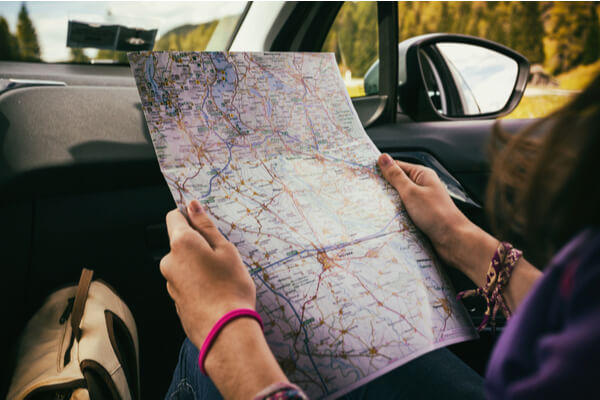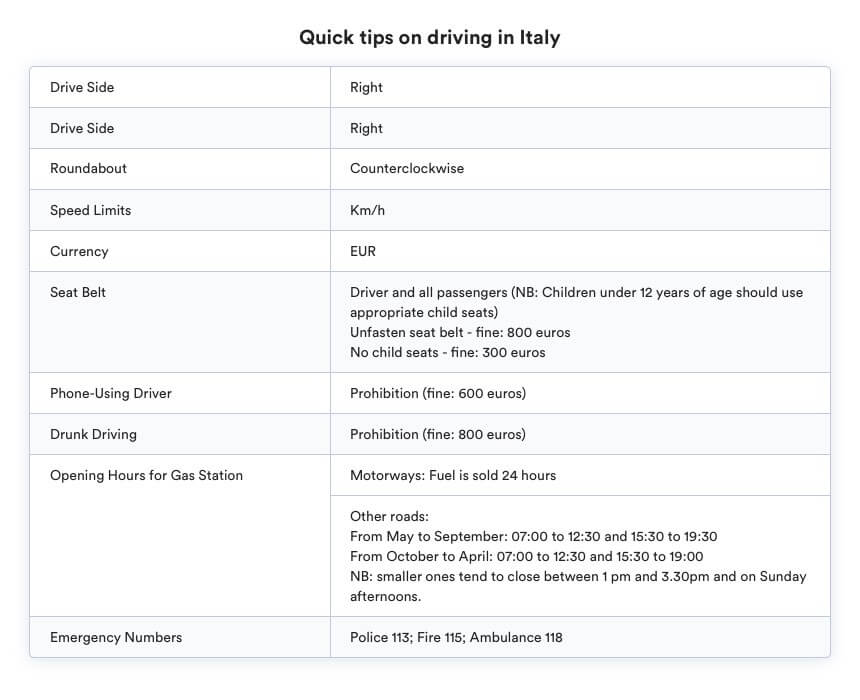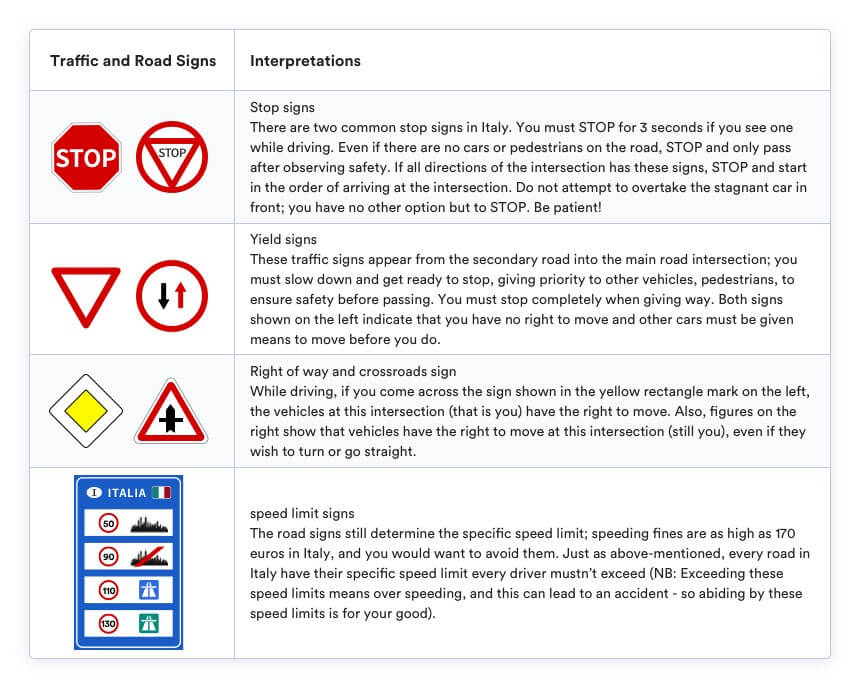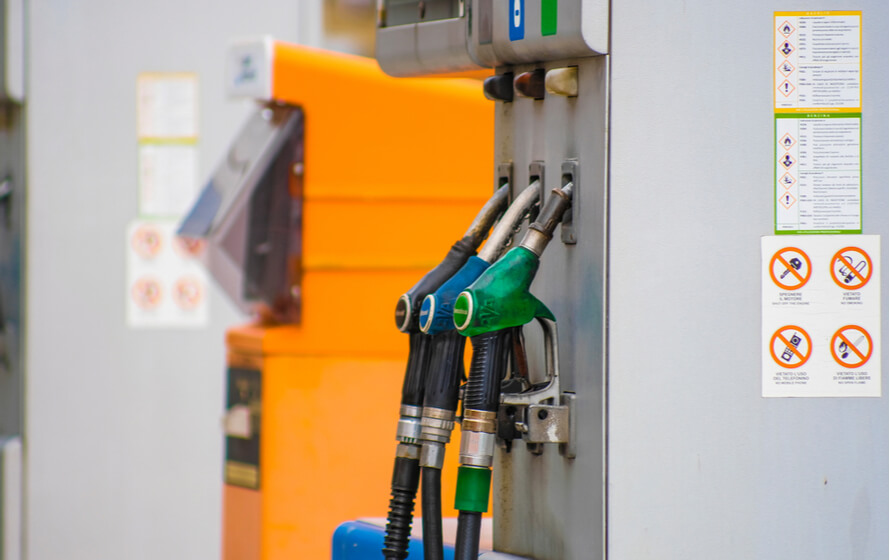Are you thinking of going to Italy and driving around by yourself? As a first time visitor in Italy, there are some essential things you should know if you want your driving in Italy to be fun and relaxing.
Every country has rules that drivers must abide by. Failing to follow these rules would result in a fine, and the phrase ‘fine’ isn’t a favorite for most foreign drivers. So before traveling to Italy, you need to be well informed. In this article, you’ll get full insight into driving in Italy. Before diving into the principal purpose of this article, let’s quickly look at some tips about driving in Italy!
1. Driving Rules in Italy
- Speed Limits
The speed limits and signs in Italy are read in Kilometres per hour (km/h).
Autostrada/Motorways has a speed limit of 130 km/h.
Maggiore fuori città/Major out-of-town road has a speed limit of 110 km/h.
Minore fuori città/Minor out-of-town roads have a speed limit of 90 km/h.
Zona Urbana/Urban area has a speed limit of 50 km/h.
Expert Tips: If you have only held your license for three years or less, your speed limit should not exceed 100 km/h on motorways and 90 km/h on truck roads and main highways. Also, in the case of rain or snow, your limit should not exceed 110 km/h on motorways and 90 km/h on Major out-of-town roads.
- Traffic Signs
For more information about Italian road signs, here is an infographic from QEEQ.COM.
- Driving Tips in Italy Only
ZTL – The most important thing to know when driving in Italy!
What is ZTL in Italy and why
Zona Traffico Limitato (ZTL), also called Limited Traffic Zones, is a restricted traffic area in Italy. In bilingual zones in Italy, such as Valletta and Bolzano, they both have their own unique ZTL names. Zone à Trafic limité is the ZTL name for Valetta, while Zone mit beschränktem Verkehr is the ZTL name for Bolzano.
Why ZTL
The purposes of these areas are to raise taxes, protect historic neighborhoods, and to subdue pollution from traffic jams in the city center. ZTL is in almost all Italian town centers.
Rules for ZTL
While driving in Italy, you must pay attention to the ZTL signs at the crossroads, traffic lights, and turntables.
A ZTL sign always appears 150 meters away from the ZTL area, indicating that you are about entering the ZTL.
There are surveillance cameras and unique traffic lights in each entrance to ZTL. If you enter a restricted area, a camera will capture your license plate, and you will likely get a fine in your mail (within the month or months later). You can pass if the special traffic light is green, but you have no other option but to reverse if the light is red. Also, if there is a time shown on the ZTL sign, this means no entry around that specific time, but if not, this means no entry throughout the day.
Entering ZTL comes with a considerable fine, ranging from 50 to 150 Euros – and it can accumulate based on how far or the number of circles you made (NB: European Municipality Outsourcing collects various traffic violations in Italy, including ZTL fines. Fines must be paid even if you entered accidentally).
Three ways to enter ZTL
i. Apply for a pass, or get one at a smokeshop for as little as 5 Euros. After getting your pass, text the I.D. code and your license plate to the DMV. The validity of each pass is 24 hours only.
ii. Find a parking lot within 20 minutes after driving into ZTL. These lots are marked ‘ZTL Parking,’ and they’re costly. Afterward, your entry record will be canceled automatically or manually by the parking lots.
iii. If you stay in a hotel in ZTL, the hotel receptionist will go to the police station and cancel your entry record. It is advisable to plan and try to choose hotels outside the ZTL area when booking.
Expert tips: Select your destination city on this website to see the corresponding details of the ZTL restrictions. Which are; the hours of operation, penalty fee, enforcement used, and how to make payment.
- Drive with Your Lights On
Outside urban areas, you are to drive with your headlights on, even on sunny days. Always keep your lights on while driving on Autostrada.
- Do Not Rely Too Heavily on GPS
If you are new to a navigator, then get used to it before traveling to Italy.
Though navigating with a GPS is convenient, please do not rely on it solely when driving in Italy, as you can easily find two or more towns with similar names in different regions. So get a map to ensure you are on the right path.
- Driving on Sundays
As a visitor, driving in Italy on Sunday makes your trip less stressful and very relaxing, because large trucks are not allowed to drive on Sunday. You can take advantage of Italians wanderlust tradition – leisurely drives around the countryside on a Sunday, and make your stay in Italy a memorable and fun-filled one.
2. Road Conditions and Driving Style in Italy
- Road Conditions
While driving in Italy, you might encounter road conditions different from those in the US, as some of the roads are narrow, and winding.
Be careful to drive in the rural areas during the winter! You may encounter fog and low visibility and they often lack guardrails. This might force you off the motorways and even make you drive on routes meant for horses and carriages.
Also, on Italian two-lane roads, there are unofficial third middle lanes known as the passing lane. Italians know how to use it better, so while driving when someone roars behind you; make way for them to operate in the middle path by moving to the right.
- Driving Styles
The phrase – if you cannot beat them, join them, does not apply to the way of driving in Italy. Driving like Italians means fast and aggressively. They are known for tailgating, unlike in other European countries where it is rare to see a driver tailgating another. So, care less about their aggressive style of driving and maintain your lane and speed limit, if you do not want to go against the law, or be involved in an accident.
While we portray Italians as fast and aggressive drivers, they are as well disciplined on the freeways, unlike in the U.S.
Expert tips: Avoid driving on the left lane except you see an opportunity to overtake, and before you do – horn first to signal the driver in front.
3. Toll Roads
You would be charged approximately 1 euro for driving on toll roads in Italy.
How to pay the tolls?
Here are two primary payment methods:
i. Pay first
Some toll roads in Italy requires you to put a coin into the automatic coin machine, which lifts the railing afterward. Vehicles can pass and drive on these toll roads. The toll road fee is usually 2 Euros. Prepare some coins with you, as the machine does not offer change.
ii. Pay later
When driving on a toll road, follow the instructions on the sign and press the red button of the machine, you would receive a paper card, indicating the time and the name of the entrance. Then, the crossbar will open, and you can drive on these roads. If you have any problem, there is a help button beside the card which you can press, and it will automatically connect to the voice system of the high-speed worker, but be aware that he/she may not speak English.
Before exiting toll roads, there are clear signs to guide you to the different payment channel, namely Telepass channel, credit card channel, and cash channel. Choose the one which suits you the best.
i. Telepass: for vehicles equipped with Telepass, the toll fee will automatically deduct when you pass through. Add Telepass if you plan to drive on many toll roads, or pay a one-time charge if you have no intention to operate more than once.
ii. Credit card: insert your card to the payment machine. The toll fee will show on the screen, and you have to follow the simple payment steps to make payment.
iii. Cash: Give your highway card which you get from the entrance to the staff and give them the said amount.
4. Ticket
Most car rental companies will help you with the payment of fines. After receiving the traffic violation information, your car rental company will deduct the violation penalty and management fee from the credit card, which you used in picking up your car at the rental desk.
However, if the car rental company does not offer help with the payment service, you would have to pay by yourself. After receiving the ticket, you can pay following the instruction on the website you’d see on the card. Make payment with your ticket number.
Expert tips: Pay your ticket as soon as possible to avoid paying the late fee.
5. Gas
- Knowing the Pumps
Looking at the picture below, most of the gasoline senza piombo has a green oil gun on the left, while most of the diesel has a black oil gun on the right. You have self-service (fai da te) pumps that you can use any time. Remember, there’s a distinguishable feature between benzina (petrol) and gasolio (diesel).
Be careful not to add the wrong fuel, and if you do, please contact the store as soon to request the fuel tank and oil line system to be cleaned ASAP. Afterward, conduct a comprehensive inspection of the engine and do not start rashly to avoid injury.
How to pay
i. Self-service refueling: input the fuel pound number, fuel liter number, choose cash/credit card to pay, and then take off the corresponding fuel gun to refill.
ii. Support from filling station: If you choose manual refueling, staff will be responsible for refueling, and the price will be slightly higher because of that gesture.
Expert tips: Most European cars use diesel, so be sure to confirm the type of fuel. When you rent a car, consider a diesel-powered compact economy car, as diesel vehicles get better fuel economy, and diesel itself will cost you less.
6. Parking
In Italy, each region has its parking regulations. In some cities, there are local restrictions on the times appropriate for you to enter and park your car. You are likely to face a severe penalty if you go against parking regulations in Italy, even if unintentional. Below is information on where to park and we are available if you need any help with parking restrictions before you hit the road.
- Public Car Park
There are free public parking lots in shopping centers and supermarkets. However, scenic spots and prosperous areas are generally fee-paying parking lots.
- Roadside Parking
Free parking on the roadside has some requirements and is usually time-limited. You must read the signs first.
However, parking in downtown areas usually incur a parking fee from 8 to 19 o’clock, and free at other times.
How to pay: Meter payment
You can make roadside meter payment with Master/Visa credit card or coin payment.
Step1: Swipe in your card or coin
Step2: Select a duration
Step3: Confirm ok
Step4: Print the ticket
Step5: Place it on the windshield
NB: There are two types of paid car parks, one for pre-payment and the other for post-payment, with rates ranging from about €1.50 to €2.50 per hour, with most charging €1.50 per hour.
7. Ending
Being in charge of the wheels while touring around Italy is excellent though it can be very frustrating. Do not be afraid, as you can find it extremely rewarding if you work with the information/instructions in this article. There is no better way to get to know the country. You wouldn’t want to miss out on this glorious opportunity to explore the outskirts by automobile because of fear or lack of information about driving in Italy.
Useful information when reading the Italian signs
| English | Italian |
| Monday | il lunedì |
| Tuesday | il martedì |
| Wednesday | il mercoledì |
| Thursday | il giovedì |
| Friday | il venerdì |
| Saturday | il sabato |
| Sunday | la domenica |
QEEQ.COM invites you to give feedback!
If in the process of use, you find any mistakes or need for us to supplement this content, please leave a message and inform us. We will verify and update the error correction and supplementary information for the first time, to provide better content for travelers.





